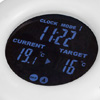Biological Pest Control
Biological Pest Control
Biological Pest control is one of the most effective forms of pest removal, In biological pest control particular varieties of predator bugs are introduced that will target your problem pest relentlessly and savagely murder and eat them. What happens then I hear you say, "won't I now have a predator bug problem". That's the great bit, once your predators have gorged themselves on every pest, egg or larvae they can find they will disperse and starve to death! cool, huh!
We don't sell any predator bugs ourselves as they have a bit of a shelf life and you want to get them fresh for maximum effect. To order any of the predators below we suggest you pay a visit to Defenders.co.uk. Defenders have a proven history of supplying quality biological pest control products to UK gardeners and are always extremely helpful if you give them a call.
Spidermite Predators - phytoseiulus persimilis
Phytoseiulus persimilis is a predatory mite capable of eating large numbers of red and two spotted spider mites, Phytoseiulus is a very active and quick moving predator which will actively hunt out spidermites wherever they are hiding. It is slightly larger than the red or two spotted spider mite with a tear shaped red body and long legs, juveniles are oval and pale pink.
Each Phytoseiulus can produce 50-60 eggs in 3 weeks. Egg to adult takes about 12 days at 20ºC (68ºF), and half that at 30ºC. Many hundreds of spider mites will be eaten by a single Phytoseiulus during its life cycle, and it will eat all stages of two spotted and red spider mite. Phytoseiulus reproduces at twice the rate of spidermites at 18ºC (64ºF) and above. If all the spider mites are eaten, Phytoseiulus will disperse and die.

Behold the phytoseiulus persimilis predator mite in all its glory. Run and hide spidermite scum!
Phytoseiulus should be introduced at the first sign of a spider mite infestation, when using predator mites stop any pest spraying regimes as these will kill the predators as well as the spidermites. The air temperature must be around 20ºC (68ºF) for at least part of the day and humidity should be kept fairly high by damping down or misting. The temperature must not fall below 10ºC (50ºF).
Defenders supply Phytoseiulus in 3 dose sizes for different area covereages, each dose is sent out mixed with vermiculite carrier grains. Phytoseiulus are simply released from the tube they are sent in onto the leaves of affected plants. Phytoseiulus cannot be stored, it needs to be used immediately upon receipt.
As a basic rule you should achieve control of red spider mite in about three weeks if the starting ratio of red spider mite to Phytoseiulus is no greater than 20 spider mite to 1 Phytoseiulus. You will know when Phytoseiulus is working as new foliage will not show signs of damage.
Like all Defenders biological controls, Phytoseiulus is harmless to children, pets and wildlife and will not become a pest in its own right.

I don't know about you guys but theres something very satisfying about looking at pictures of spidermites being horrifically murdered. Phytoseiulus persimilis eating two spotted and red spidermites respectively.
Thrip Predators - amblyseius cucumeris
Amblyseius cucumeris are small very active predatory mites. They are about 1 millimetre long, pale brown in colour and have slightly flat pear shaped bodies. Amblyseius are used to control thrips.
Amblyseius cucumeris adults produce several eggs a day and are quite long lived. Both the adults and young mites eat thrips and have been known to eat young spider mites also.

Don't let his podgy body and short stubby limbs fool you, Amblyseius is a ruthless killer!
Amblyseius requires a temperature of 18°C (64°F). Amblyseius should be introduced to the growing environment on the day of receipt.
Defenders supply Amblyseius in sachets known as "breeder" packs where the mites are mixed with bran. These "breeder" packs are simply hung among your plants. A food supply for Amblyseius is also contained in the sachet, and it is therefore possible to introduce them to the crop before thrips numbers have built up.
Amblyseius are sensitive to long hot dry spells, so damping down or misting can help at these times. Amblyseius sachets should not be placed in direct sunlight or near to heating pipes.
Like all Defenders biological controls, Amblyseius is harmless to children, pets and wildlife and will not become a pest in its own right.

Die thrips, die!
Fungus Gnat Predators - hypoaspis miles
Hypoaspis miles are soil-dwelling mites which grow up to around 1mm in length and are light brown in color. The younger, nymph stage is almost white. Hypoaspis naturally inhabits the top layer of soil or compost. It is used for controlling Sciarid flies (also known as fungus gnats). Hypoaspis kills gungus gnat larvae not the flying gnats themselves which will die out quite quickly once their larvae are erradicated.
Egg to adult takes about 34 days at 15ºC (60ºF) and 9 days at 28ºC. Hypoaspis adults and larvae both feed on fungus gnat eggs and larvae. Hypoaspis miles can live for several weeks without food, and so can be used as a preventative measure. Adults will remain active for up to 4-5 months.

Hypoaspis miles
Hypoaspis requires a minimum temperature of 10ºC (50ºF) Hypoapis prefers humid conditions and temperatures between 16ºC and 30ºC. Hypoaspis miles should be used on the day of receipt.
Hypoaspis miles predators are supplied mixed with vermiculite / peat and sent out in an easy to use pack, they are simply sprinkled on affected plants, (approx. 1 teaspoon per pot).
Like all Defenders biological controls, Hypoaspis miles is harmless to children, pets and wildlife and will not become a pest in its own right.

Hypoaspis miles in action. Fungus gnat larvae and eggs will never knew what hit them.





